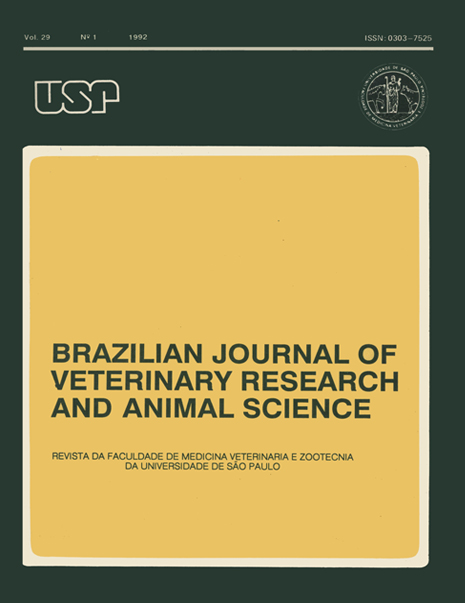"Paracoccidioidomycosis-infection" Survey in Brazilian Captive primates (Cebus apella)
DOI:
https://doi.org/10.11606/issn.1678-4456.bjvras.1992.51950Keywords:
Mycoses (paracoccidioidomycosis), Paracoccidioidomycosis, South-America blastomycosis PrimatesAbstract
The aim of this study was to verify the possible occurrence of paracoccidioidomycosis-infection in animals that belong to the Order Primates, once they are phylogenetically closest to the only naturally susceptible host of the disease, the human being. This research was essayed using paracoccidioidin delayed hypersensitivity test in 33 Cebus apella, "weeping-capuchin". Paracoccidioidin positive skin reactions were detected at a rate of 33.33%. The humoral immunological response was detected by complement fixation test in 10% of the performed sera. Histological examinations of the intradermic test biopsies showed the presence of focal or nodular dermatitis deep in the dermis, prevailing the polymorphonuclear neutrophils both at 24 and 48 hours after inoculation, with oedema, congestion, and mild vasculitis. The results obtained in this study indicated that Cebidae are susceptible to natural "paracoccidioidomycosis - infection" and are suitable to be used in epidemiological surveys.Downloads
Download data is not yet available.
Downloads
Published
1992-06-01
Issue
Section
PREVENTIVE VETERINARY MEDICINE
License
The journal content is authorized under the Creative Commons BY-NC-SA license (summary of the license: https://
How to Cite
1.
Costa EO da, Diniz LSM, Fava Neto C, Arruda C, Dagli MLZ. "Paracoccidioidomycosis-infection" Survey in Brazilian Captive primates (Cebus apella). Braz. J. Vet. Res. Anim. Sci. [Internet]. 1992 Jun. 1 [cited 2024 Apr. 19];29(1):39-44. Available from: https://www.revistas.usp.br/bjvras/article/view/51950





